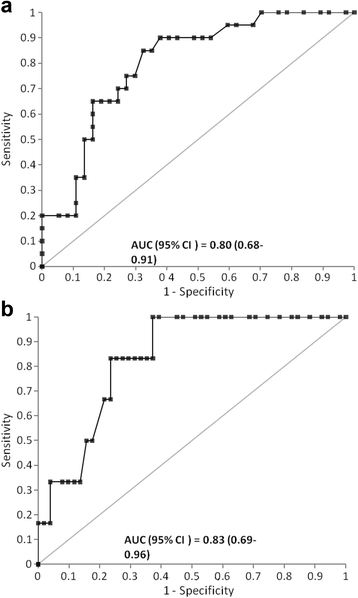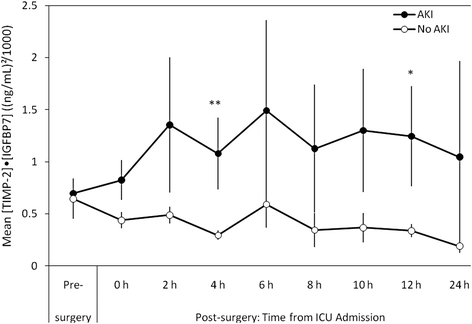Urinary TIMP-2 and IGFBP7 for the prediction of acute kidney injury following cardiac surgery
- PMID: 28558754
- PMCID: PMC5450378
- DOI: 10.1186/s12882-017-0592-8
Urinary TIMP-2 and IGFBP7 for the prediction of acute kidney injury following cardiac surgery
Abstract
Background: Acute kidney injury (AKI) following cardiac surgery is common and associated with poor patient outcomes. Early risk assessment for development of AKI remains a challenge. The combination of urinary tissue inhibitor of metalloproteinase 2 (TIMP-2) and insulin-like growth factor binding protein 7 (IGFBP7) has been shown to be an excellent predictor of AKI following cardiac surgery, but reported studies are for predominately non-Asian populations.
Methods: Adult patients were prospectively enrolled at Zhongshan hospital in Shanghai, China. The primary analysis was prediction of AKI and stage 2-3 AKI by [TIMP-2]*[IGFBP7] measured 4 h after postoperative ICU admission assessed using receiver operating characteristic curve (ROC) analysis. Kinetics of [TIMP-2]*[IGFBP7] following ICU admission were also examined.
Results: We prospectively enrolled 57 cardiac surgery patients, of which 20 (35%) developed AKI and 6 (11%) developed stage 2-3 AKI. The area under the ROC curve (AUC) of [TIMP-2]*[IGFBP7] at 4 h after ICU admission was 0.80 (95% confidence interval (CI): 0.68-0.91) for development of AKI and 0.83 (95% CI: 0.69-0.96) for development of stage 2-3 AKI. Urinary [TIMP-2]*[IGFBP7] values at 4 h after ICU admission were significantly (P < 0.001) higher in patients who developed AKI than in patients who did not develop AKI (mean (standard error) of 1.08 (0.34) (ng/mL)2/1000 and 0.29 (0.05) (ng/mL)2/1000, respectively). The time-profile of [TIMP-2]*[IGFBP7] suggests the markers started to elevate by the time of ICU admission in patients who developed AKI and either decreased or remained flat in patients without AKI.
Conclusion: The combination of urinary TIMP-2 and IGFBP7 4 h after postoperative ICU admission identifies patients at risk for developing AKI, not just stage 2-3 AKI following cardiac surgery.
Keywords: Acute kidney injury; Biomarker; Cardiac surgery; IGFBP7; TIMP-2.
Figures


Similar articles
-
Intraoperative prediction of cardiac surgery-associated acute kidney injury using urinary biomarkers of cell cycle arrest.J Thorac Cardiovasc Surg. 2019 Apr;157(4):1545-1553.e5. doi: 10.1016/j.jtcvs.2018.08.090. Epub 2018 Sep 26. J Thorac Cardiovasc Surg. 2019. PMID: 30389130 Free PMC article.
-
Tissue Inhibitor Metalloproteinase-2·IGF-Binding Protein 7 for the Prediction of Acute Kidney Injury following Cardiac Surgery.Cardiorenal Med. 2024;14(1):251-260. doi: 10.1159/000538031. Epub 2024 Apr 8. Cardiorenal Med. 2024. PMID: 38588650
-
Urinary biomarkers TIMP-2 and IGFBP7 early predict acute kidney injury after major surgery.PLoS One. 2015 Mar 23;10(3):e0120863. doi: 10.1371/journal.pone.0120863. eCollection 2015. PLoS One. 2015. PMID: 25798585 Free PMC article. Clinical Trial.
-
The Accuracy of Urinary TIMP-2 and IGFBP7 for the Diagnosis of Cardiac Surgery-Associated Acute Kidney Injury: A Systematic Review and Meta-Analysis.J Intensive Care Med. 2020 Oct;35(10):1013-1025. doi: 10.1177/0885066618807124. Epub 2018 Oct 30. J Intensive Care Med. 2020. PMID: 30376758
-
Will urinary biomarkers provide a breakthrough in diagnosing cardiac surgery-associated AKI? - A systematic review.Biomarkers. 2020 Jul;25(5):375-383. doi: 10.1080/1354750X.2020.1777199. Epub 2020 Jun 19. Biomarkers. 2020. PMID: 32479185
Cited by
-
BPI fold-containing family a member 2 as a biomarker of acute kidney injury-close but no (clinical) cigar?Ann Transl Med. 2018 May;6(10):191. doi: 10.21037/atm.2018.03.13. Ann Transl Med. 2018. PMID: 29951513 Free PMC article. No abstract available.
-
Risk Scoring Systems Including Electrolyte Disorders for Predicting the Incidence of Acute Kidney Injury in Hospitalized Patients.Clin Epidemiol. 2021 May 27;13:383-396. doi: 10.2147/CLEP.S311364. eCollection 2021. Clin Epidemiol. 2021. PMID: 34093042 Free PMC article.
-
The multifaceted role of insulin-like growth factor binding protein 7.Front Cell Dev Biol. 2024 Jul 16;12:1420862. doi: 10.3389/fcell.2024.1420862. eCollection 2024. Front Cell Dev Biol. 2024. PMID: 39081862 Free PMC article. Review.
-
Predictive Accuracy of a Perioperative Laboratory Test-Based Prediction Model for Moderate to Severe Acute Kidney Injury After Cardiac Surgery.JAMA. 2022 Mar 8;327(10):956-964. doi: 10.1001/jama.2022.1751. JAMA. 2022. PMID: 35258532 Free PMC article.
-
CIRP attenuates acute kidney injury after hypothermic cardiovascular surgery by inhibiting PHD3/HIF-1α-mediated ROS-TGF-β1/p38 MAPK activation and mitochondrial apoptotic pathways.Mol Med. 2023 May 1;29(1):61. doi: 10.1186/s10020-023-00655-0. Mol Med. 2023. PMID: 37127576 Free PMC article.
References
-
- Wang Y, Fang Y, Teng J, et al. Acute kidney injury epidemiology: from recognition to intervention. Contrib Nephrol. 2016;187:1–8. - PubMed
MeSH terms
Substances
LinkOut - more resources
Full Text Sources
Other Literature Sources
Medical
Research Materials
Miscellaneous

